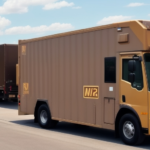What Are UPS Shipping Rates by Weight?
UPS is a leading shipping provider for both individuals and businesses, renowned for its reliable and efficient delivery services worldwide. Understanding UPS shipping rates by weight is essential for optimizing your shipping costs and ensuring timely deliveries. This article delves into the intricacies of UPS shipping rates based on weight, offers strategies to minimize shipping expenses, and provides up-to-date information to help you make informed decisions.
How Do UPS Shipping Rates Vary by Weight?
UPS shipping rates are influenced by several factors, with package weight being the most significant determinant. The heavier your package, the higher the shipping cost. To accurately determine UPS shipping rates, consult UPS's official shipping rate charts, which categorize rates based on weight brackets and service levels.
UPS offers various service levels, including Ground, 3 Day Select, 2nd Day Air, and Next Day Air. Each service level has distinct rate charts, reflecting the different delivery speeds and costs. For instance, under Ground service, a package weighing less than 1 lb typically costs less than one weighing between 1 lb and 2 lbs.
Additionally, UPS provides discounts for frequent shippers or those sending large volumes, which can significantly reduce shipping costs. Utilizing UPS's branded packaging options, such as boxes and envelopes, can also influence shipping rates based on both weight and dimensions.
When shipping internationally, UPS shipping rates are further affected by destination country, customs fees, and taxes. It's crucial to factor in these additional costs to avoid unexpected expenses.
The Importance of Understanding UPS Shipping Rates by Weight
Comprehending how UPS shipping rates fluctuate based on weight is vital for both individuals and businesses that frequently ship packages. By knowing the costs associated with different weights, you can effectively plan and budget your shipping needs, preventing unforeseen expenses.
Moreover, awareness of weight-based rates enables you to select the most cost-effective shipping option tailored to your requirements. Considering both weight and destination ensures that you optimize shipping expenses while maintaining service quality.
How to Calculate UPS Shipping Rates Based on Weight
To calculate UPS shipping rates based on weight, access UPS's official shipping rate charts, which are segmented by service level and weight brackets. These charts provide a detailed breakdown of shipping costs corresponding to package weight and destination.
Take advantage of UPS discounts available for certain shipment types, such as those enrolled in the UPS My Choice program or businesses with high shipping volumes. Be mindful of additional fees for special services like signature confirmation or Saturday delivery, as these can impact the overall shipping cost.
Factors That Affect UPS Shipping Rates by Weight
While weight is the primary factor determining UPS shipping rates, several other elements can influence the total cost:
- Destination: Shipping to distant or international locations incurs higher costs.
- Package Dimensions: Larger packages may incur dimensional weight charges.
- Service Level: Faster delivery services cost more.
- Additional Fees: Fuel surcharges, residential delivery fees, and special handling charges can apply.
- Item Type: Shipping hazardous or oversized items may require extra fees and special handling.
Always review UPS's guidelines to ensure compliance and understand any additional costs that may apply to your shipment.
Comparison of UPS Shipping Rates for Different Weight Categories
UPS provides distinct shipping rate charts based on weight categories, leading to varying costs depending on the package's weight:
- Under 1 lb: Generally the least expensive within Ground service.
- 1 lb to 2 lbs: Slightly higher rates than under 1 lb.
- 2 lbs and above: Incrementally higher costs as weight increases.
Additionally, shipping to residential addresses or remote areas can elevate costs due to increased delivery resources. Expedited services like Next Day Air or 2nd Day Air are more expensive than standard Ground shipping but offer faster delivery times, which may be necessary for urgent shipments.
Tips to Save Money on UPS Shipping Rates by Managing Weight
Optimizing package weight is a strategic approach to reducing UPS shipping costs:
- Use Lightweight Packaging: Opt for materials that offer protection without adding unnecessary weight.
- Eliminate Unnecessary Items: Remove any non-essential items from your shipment.
- Select Appropriate Packaging Size: Use the smallest possible box or envelope to avoid dimensional weight charges.
- Consider Flat-Rate Shipping: For heavier items, flat-rate options can be more economical if the items fit within the service’s size and weight limits.
Implementing these strategies can lead to significant savings, especially for businesses with high shipping volumes.
Understanding the Impact of Package Dimensions on UPS Shipping Rates
Package dimensions play a critical role in determining UPS shipping rates through the dimensional weight formula. Dimensional weight is calculated by multiplying the package's length, width, and height and dividing by a specified divisor. If the dimensional weight exceeds the actual weight, UPS charges based on the dimensional weight.
Accurately measuring your package's dimensions is essential to ensure correct pricing. Oversized or irregularly shaped packages may incur additional fees, so selecting appropriately sized packaging can help mitigate extra costs.
Moreover, the destination influences shipping rates. Choosing the right shipping option—whether Ground, Air, or International—based on your package’s dimensions and destination ensures cost-effective and timely delivery.
How to Choose the Best UPS Shipping Rate Based on Your Package Weight
Selecting the optimal UPS shipping rate involves considering multiple factors alongside package weight:
- Shipping Destination: Local versus international destinations affect rates.
- Package Dimensions: Ensure size efficiency to avoid dimensional weight charges.
- Delivery Timeframe: Balance the urgency of delivery with cost by choosing the appropriate service level.
- Additional Services: Factor in any necessary extra services like insurance or signature confirmation.
Additionally, assess the nature of the items being shipped. Fragile or hazardous materials might require special handling, impacting the overall shipping cost.
Always verify UPS’s latest shipping rates and service options by consulting their official website or contacting customer service to ensure you choose the most suitable and economical shipping rate.
Common Mistakes to Avoid When Estimating UPS Shipping Rates by Weight
Accurate estimation of UPS shipping rates depends on avoiding several common pitfalls:
- Ignoring Package Dimensions: Overlooking the impact of dimensional weight can lead to unexpected higher costs.
- Using Incorrect Rate Charts: Ensure you're referencing the correct rate chart for your selected service level and destination.
- Neglecting Additional Fees: Be aware of potential surcharges like residential delivery fees or special handling charges.
- Seasonal Rate Fluctuations: Shipping rates may vary during peak seasons; always verify rates close to your shipping date.
To avoid these mistakes, meticulously measure your package, utilize the correct rate charts, and account for all possible additional fees. Regularly consulting UPS’s official resources can also provide up-to-date information on rate changes and service options.
The Future of UPS Shipping Rates and Their Impact on E-commerce
The e-commerce landscape is continuously evolving, with the demand for reliable and cost-effective shipping services on the rise. UPS is poised to adapt its pricing strategies to remain competitive and meet the dynamic needs of online businesses. Innovations such as enhanced logistics technology, sustainable shipping options, and customizable service levels will likely influence future UPS shipping rates.
For e-commerce businesses, staying informed about UPS shipping rate trends and maintaining flexibility in shipping strategies will be crucial for maximizing profitability and ensuring customer satisfaction. Leveraging data analytics to predict shipping costs and adapting to new UPS offerings can provide a competitive edge in the fast-paced online marketplace.
In conclusion, a thorough understanding of UPS shipping rates by weight is indispensable for anyone involved in regular package shipping. By accurately assessing weight and dimensions, taking advantage of available discounts, and avoiding common estimation mistakes, you can optimize your shipping expenses. Refer to UPS's official shipping rate charts to estimate costs effectively, and choose service levels that align with your delivery needs and budget constraints.




















